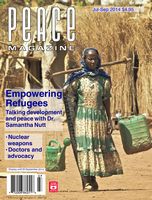
Peace Magazine Jul-Sep 2014, page 28. Some rights reserved.
Search for other articles by John Bacher here
By Rick Wallace. Black Point, NS: Fernwood 2013.
Rick Wallace’s book, Merging Fires, bridges the gulf between the two solitudes of native and newcomers in Canada. This is evident in its depiction of the protests that launched the Idle No More Movement, apparently in response to the government’s 2012 gutting of environmental protection laws.
Wallace calls the Harper assault a “weakening of regulations, reviews, and consultations concerning lakes, rivers, forests and lands.” Those facts were fairly well covered by the commercial media, if not by the editorial commentaries. However, Wallace exposes another fact that seems to have been kept secret—that the two Omnibus Bills changed the Indian Act, “reducing the level of community voting necessary to allow Indigenous communities to sell their land to pipeline consortiums.” These changes, which facilitated the construction of oil pipelines, escaped media attention, or perhaps were even suppressed by a media blackout. In any case, the three case studies in Merging Fires prove the importance of native rights as a form of “people power.”
Wallace astutely chose three previous Ontario struggles where native communities, frequently working with church, union, and environmental allies, won major victories. Each triumph challenges aboriginal apathy, political withdrawal, and cynicism—in essence, “idleness.” Such despair encourages the capture of politics by corporate elites who are indifferent to the environment and whose selfish interests are caught up in a world of illusion.
The three victories Wallace describes all promote a world more in tune with the earth-respecting values of Canada’s indigenous peoples. He shows the unique local sensitivities of each struggle, which, although all pointing to a more sustainable future, involved vastly different strategies and difficulties.The easiest path to victory lay in the negotiations between the City of Kenora and the Grand Council of Treaty Three (a coalition of Anishinaabe band councils) concerning the transfer of land from the Abitibi Consolidated Corporation to park land co-managed by Tunnel Island. Helped by the Grand Council’s earlier litigation against Abitibi, which ruled out unilateral transfer, success depended on the City Council’s recognition of Anishinaabe respect for nature.
Wallace recounts ceremonies in Kenora where “listening to the land” was critical in healing the past harm done to the land and honoring the relationship between the two cultures. The participants got “in touch with the spirit of the place, both in its magnificence and its pain,” to the benefit of both the Anishinaabe and the City of Kenora. New ideas for cultural tourism were developed by promoting a previously forgotten portage route of great importance in Canadian history.
One of the most dramatic victories that Wallace chronicles was won in the Grassy Narrows First Nation Anishinaabe. After several months of blockading logging roads in the bitterly cold weather, the Grassy Narrows First Nation, supported by the Christian Peacemaker Team and such environmental groups as ForestEthics, won a victory through litigation. The band’s land consists of a 5,000 kilometre square area established through a treaty of 1873. In August 2011 Madame Justice Mary Anne Sanderson of the Ontario Superior Court of Justice decided in favor of the Grassy Narrows band’s position that clear cutting violates their right to hunt, trap and fish. The ruling protected a large swath of what Wallace calls “relatively untouched boreal forest.”
The most difficult victory Wallace describes was the Cape Croker Ojibway’s battle to take part in a limited way in the Georgian Bay commercial fishery. They won in 2000 after several years of conflict, including criminal assaults such as youth stabbing, and burning of fishing boats and equipment by racists. A negotiated agreement was achieved with the federal and provincial governments, which assured the Saugeen people the right to fish within an agreed-upon area. It also provided funds to the Saugeen-Objiway Nation for research and monitoring of the commercial fisheries within that area.
Merging Fires could have been improved if Wallace had named the real heroes and villains of his story. Unfortunately, some of the villains, including the former politician Bill Murdoch, are household names, known to millions and still influencing public opinion. Murdoch has an enormous audience as a popular radio talk show host. His continuing deleterious influence can be inferred from such events as Ontario Premier Kathleen Wynne’s revival of the spring bear hunt, over the protests of environmentalists. Murdoch had broken with his former patron, Conservative Premier Mike Harris, when Harris cancelled the hunt. Yet Murdoch, as a radio celebrity, probably enjoys a high enough profile today to influence public policy, whereas the heroes of the story remain unsung. While praising their deeds, Wallace simply refers to them anonymously as “organic intellectuals.” He could have helped to redress the power imbalance by naming them in his book.
Reviewed by John Bacher, a St. Catharines-based writer and activist.

Peace Magazine Jul-Sep 2014, page 28. Some rights reserved.
Search for other articles by John Bacher here